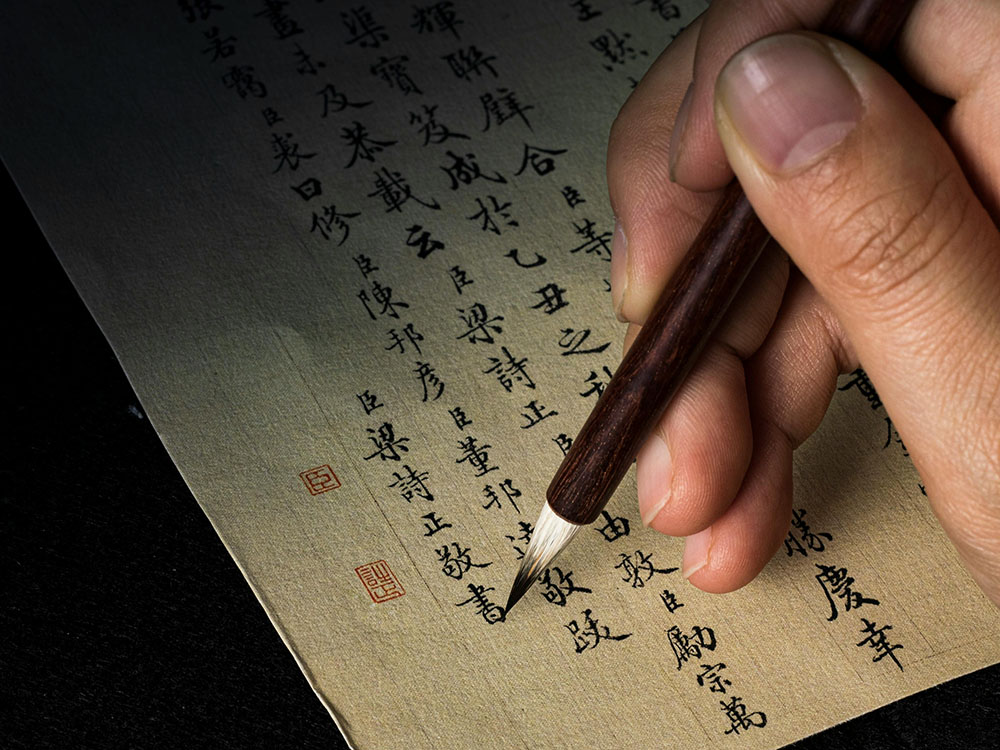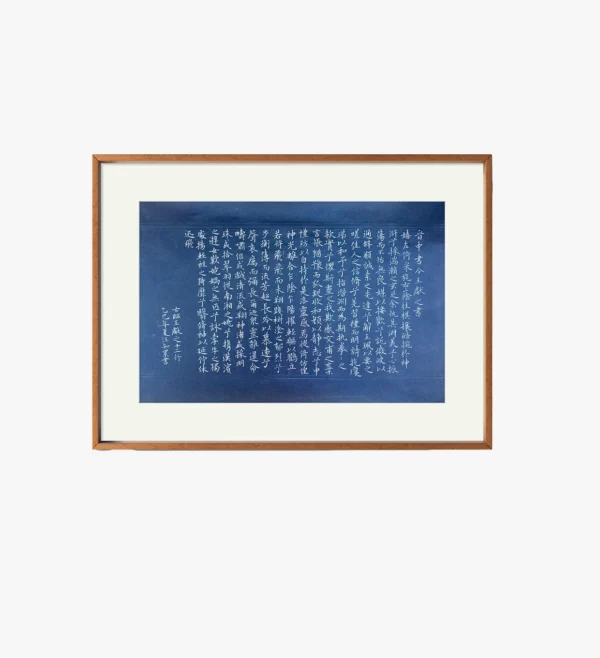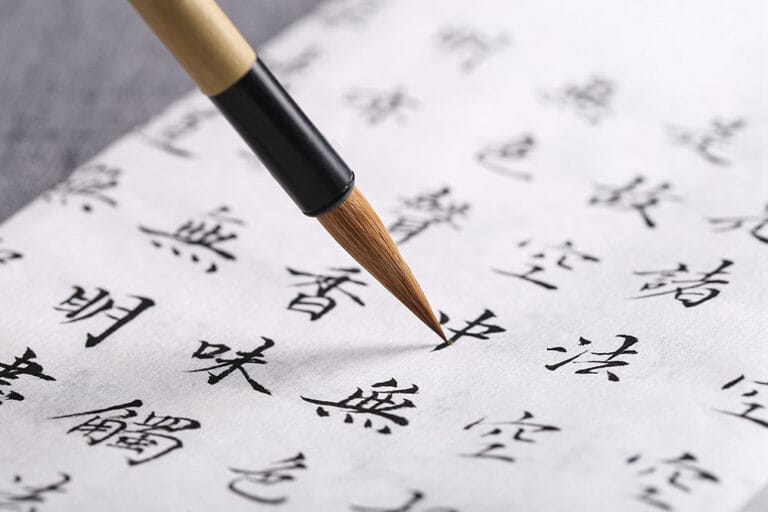Written with love, shared with joy.
The Xiaokai: the Art of Small Regular Calligraphy

What is Small Regular Calligraphy?
Xiaokai (小楷), or Small Regular Calligraphy, is a refined form of Chinese calligraphy characterized by its delicate and smaller-sized characters. It is a variation of the Regular Script (楷书) but written with meticulous detail and precision. Xiaokai is often used for small-scale and daily use works about 1-2cm size each character, including personal letters, book annotations, and inscriptions, where both readability and elegance are paramount. The art of Xiaokai demonstrates the calligrapher’s skill, patience, and understanding of Chinese culture and aesthetics.
The History
Xiaokai has a long and storied history, originating during the Eastern Jin Dynasty (317-420 AD). During this time, calligraphy began transitioning from the larger, more flamboyant styles to smaller, more practical forms. Renowned calligraphers like Wang Xizhi (王羲之) and Wang Xianzhi (王献之) were instrumental in shaping the foundations of Xiaokai. By the Tang Dynasty (618-907 AD), Xiaokai had evolved into a distinct and respected style, further refined by masters such as Ouyang Xun (欧阳询) and Yan Zhenqing (颜真卿). Their contributions solidified Xiaokai as an essential script for both artistic and practical purposes, and their works continue to inspire calligraphy enthusiasts today.
Key Characteristics of Small Regular Calligraphy
- Size: Xiaokai characters are written in a compact size, often no larger than a coin. This requires the calligrapher to have exceptional control over their brush and ink flow.
- Structure: Despite their small size, the characters retain the precise and balanced structure of Regular Script. Each stroke must be proportionate and harmoniously integrated with the character as a whole.
- Detail: The small scale of Xiaokai demands an extraordinary level of attention to detail. Every stroke, dot, and line must be executed with care to achieve clarity and elegance.
- Elegance: Xiaokai is celebrated for its refined and graceful appearance. It combines technical mastery with artistic expression, making it a favorite among collectors and art enthusiasts.
Tools for Writing it
To achieve the intricate details of Xiaokai, the following tools are essential:
- Brush: A fine-tipped brush is crucial. Brushes made from goat hair or a mix of goat and wolf hair are preferred, as they provide flexibility and precision.
- Ink: High-quality ink ensures smooth, consistent lines. Handmade or premium-grade inksticks are ideal for Xiaokai to achieve deep, rich tones.
- Paper: Thin yet durable rice paper works best for Xiaokai. It allows the brush to glide smoothly while preserving the integrity of the strokes.
- Inkstone: A well-crafted inkstone is used to grind the inkstick and mix it with water. This process ensures the right ink consistency, which is critical for small-scale writing.
Techniques for Mastering Small Regular Calligraphy
- Practice Basic Strokes: Start by mastering the fundamental strokes of Chinese calligraphy, such as horizontal lines, vertical lines, dots, and hooks. Focus on achieving consistent thickness and smooth transitions.
- Study Classic Works: Carefully observe and replicate the works of Xiaokai masters. Pay attention to stroke order, spacing, and the overall composition of characters.
- Perfect Proportions: Maintain the correct proportions within each character. This involves balancing the width and height of strokes, as well as the spacing between them.
- Control Brush Movement: Use steady and deliberate brush movements to achieve clean, crisp lines. Practice exercises that improve hand stability and precision.
- Daily Practice: Consistency is key. Dedicate time each day to practice Xiaokai, starting with simple characters and gradually progressing to more complex ones.
Famous Calligraphers
- Wang Xizhi (王羲之): Known as the “Sage of Calligraphy,” Wang Xizhi’s work set the standard for Xiaokai with its fluidity and balance.
- Yan Zhenqing (颜真卿): A Tang Dynasty master, Yan’s Xiaokai is noted for its robustness and clarity, embodying strength and elegance.
- Ouyang Xun (欧阳询): His meticulous and disciplined Xiaokai style has been widely studied and emulated by later generations.
- Zhao Mengfu (赵孟頫): A Yuan Dynasty artist, Zhao’s Xiaokai combines smooth brushwork with a sense of vitality, making his works highly sought after.
Applications of Xiaokai
- Artistic Creations: Xiaokai is frequently used in calligraphy scrolls, paintings, and decorative pieces. Its intricate beauty adds depth and sophistication to artworks.
- Literary Transcriptions: Classical poems, essays, and scriptures are often transcribed in Xiaokai, showcasing the harmony between literature and visual art.
- Educational Materials: Xiaokai serves as a teaching tool in calligraphy classes, helping students develop fine motor skills and an appreciation for structure.
- Personal Correspondence: Xiaokai has been traditionally used for writing letters and notes, as its elegance reflects the writer’s sincerity and refinement.
To illustrate the delicate balance and precision of Xiaokai, here is one of my recent works — a reproduction of Wang Xianzhi’s Thirteen Lines, featuring verses from Cao Zhi’s Rhapsody on the Luo River Goddess.
Handwritten Chinese Calligraphy Wall Hanging of Rhapsody on the Luo River Goddess
Dimensions: 70 cm x 50 cm.
The piece embodies the refined rhythm and subtle grace that make Xiaokai so captivating — each stroke composed with restraint, yet full of emotion. You can view the complete artwork here, and it’s available for collectors who appreciate the quiet beauty of traditional Chinese calligraphy.
Why Learn it?
- Skill Development: Writing Xiaokai improves hand-eye coordination, brush control, and overall calligraphy skills.
- Cultural Connection: It offers a deeper understanding of Chinese cultural heritage and artistic traditions.
- Mindfulness Practice: The focus and patience required for Xiaokai make it a calming and meditative activity, promoting mental clarity and relaxation.
- Artistic Fulfillment: Mastering Xiaokai allows you to create beautiful works of art that combine technical skill with personal expression.
Common Challenges and How to Overcome Them
- Tiny Strokes: Writing such small characters can be challenging. Use high-quality brushes and practice regularly to build confidence.
- Maintaining Clarity: It’s easy for strokes to blur or merge in small-scale writing. Adjust ink consistency and ensure your brush has a fine tip.
- Balancing Composition: Achieving balance in small characters requires a sharp eye for detail. Study classic examples and practice aligning strokes within each character.
Conclusion
Xiaokai is a captivating and intricate form of Chinese calligraphy that demands precision, patience, and dedication. By understanding its history, techniques, and applications, you can appreciate the art form on a deeper level. Whether you are a beginner or an experienced calligrapher, mastering Xiaokai offers both a rewarding artistic journey and a meaningful connection to Chinese culture.



